|
||||||
|
CARPINUS. Hornbeam. [Betulaceae] |
|
|
Only one species of Carpinus is recorded in Britain - Hornbeam (C. betulus). Twenty-four British miners are recorded on Carpinus. A key to the European mines recorded on Carpinus is provided in Bladmineerders van Europa. |
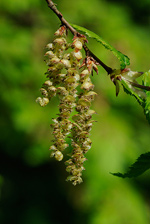 Hornbeam Carpinus betulus |
Key for the identification of the known mines of British |
Note: Diptera larvae may live in a corridor mine, a corridor-blotch mine, or a blotch mine, but never in a case, a rolled or folded leaf, a tentiform mine or sandwiched between two more or less circular leaf sections in later instars. Pupation never in a cocoon. All mining Diptera larvae are leg-less maggots without a head capsule (see examples). They never have thoracic or abdominal legs. They do not have chewing mouthparts, although they do have a characteristic cephalo-pharyngeal skeleton (see examples), usually visible internally through the body wall. The larvae lie on their sides within the mine and use their pick-like mouthparts to feed on plant tissue. In some corridor miners frass may lie in two rows on alternate sides of the mine. In order to vacate the mine the fully grown larva cuts an exit slit, which is usually semi-circular (see Liriomyza huidobrensis video). The pupa is formed within the hardened last larval skin or puparium and as a result sheaths enclosing head appendages, wings and legs are not visible externally (see examples). See Key to non-Diptera. |
1 > Leaf-miner: Larva forming a narrow, unusually long, upper surface leaf-mine up to 12 cms, sometimes considerably widening at end; young leaves are frequently distorted (Spencer, 1976: 93, fig. 130). An unusually long, upper-surface corridor that widens only little and winds freely through the leaf. Frass in two neat rows. Pupation outside the mine; exit slit (always?) in the lower epidermis. A long, greenish, winding, upper surface gallery which sometimes broadens considerably at the end. |
|
Agromyza alnibetulae Hendel, 1931 [Diptera: Agromyzidae]. |
|
Key for the identification of the known mines of British |
Note: The larvae of mining Coleoptera, Hymenoptera and Lepidoptera may live in a corridor mine, a corridor-blotch mine, a blotch mine, a case, a rolled or folded leaf, a tentiform mine or sandwiched between two more or less circular leaf sections in later instars. Larva may pupate in a silk cocoon. The larva may have six legs (although they may be reduced or absent), a head capsule and chewing mouthparts with opposable mandibles (see video of a gracillarid larva feeding). Larvae of Hymenoptera and Lepidoptera usually also have abdominal legs (see examples). Frass, if present, never in two rows. Unless feeding externally from within a case the larva usually vacates the mine by chewing an exit hole. Pupa with visible head appendages, wings and legs which lie in sheaths (see examples). |
1a > Leaf-miner and case-bearer: The larva lives outside the mine, protected by a case, and feeds on the underlying plant tissues via a hole cut in the epidermis. From that point it eats away as much leaf tissue as it can reach without fully entering the mine. Mine does not contain frass (Coleophora species) |
| 1b > Leaf-miner, but not a case-bearer: The larva lives mainly inside the mine. Mine usually contains frass. In later instars the larva may live sandwiched between two more or less circular sections cut from the leaf. |
2a > Leaf-miner and case-bearer: The early case is tiny and the larva makes a series of tiny holes on the leaf. After overwintering it makes a shiny pistol shaped case in spring and window feeds British leafminers). The young larva, before hibernation, makes tiny mines, sometimes tens in one leaf. After hibernation window feeding is done. In this latter stage the larva lives in a shining black pistol case of about 7 mm, that, with a mouth angle of 70°-80°, stands almost perpendicular on the leaf. |
|
Coleophora anatipenella (Hübner, 1796) [Lepidoptera: Coleophoridae]. |
2b > Leaf-miner and case-bearer: Larva mines leaves. The case is enlarged several times by mining a leaf-edge and inserting the existing case into the mine which is joined with silk. The final case is 7-8 mm long. Larva in a composite leaf case, composed of large leaf fragments. Characteristically, the leaf fragments are attached in a failry untidy way. In spring the case has two colours, because the old material (dull yellowish, grey or pink) dates from before the hibernation, while new, reddish brown material dates from after the winter. The case finally is about 7-8 mm long; the mouth angle is 40-45°.. |
|
Coleophora binderella (Kollar, 1832) [Lepidoptera: Coleophoridae]. |
2c > Leaf-miner and case-bearer: The full grown larva lives in a dull black pistol case of c 9 mm that, with a mouth angle of 80-90° stands erect on the leaf. Characteristic is the presence of some ear-like flaps. At least after the hibernation the larvae do not mine any more, but rather cause skeleton feeding. |
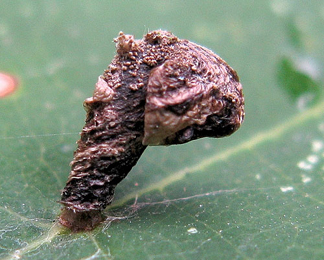 Case of Coleophora currucipennella on Quercus rubra Image: © Paul van Wielink (Bladmineerders van Europa) |
|
Coleophora currucipennella Zeller, 1839 [Lepidoptera: Coleophoridae]. |
2d > Leaf-miner and case-bearer: Lobe case. Many small leaf fragments are attached to the tubular case; its end is strongly curved downwards. The larvae are attached to the leaf underside, where they make a large number of relatively small full depth mines. |
|
Coleophora fuscocuprella Herrich-Schäffer, 1855 [Lepidoptera: Coleophoridae]. |
2e > Leaf-miner and case-bearer: Larva mining leaves, the blotches brownish. The final case is 8-11 mm long, slender, and fixed at 45° to leaf surface, with anal end laterally compressed. The case has a serrated keel due to formation from the edge of a leaf. Spatulate leaf case. Strikingly slender, bivalved case, 8-11 mm long, with a slight curve at the rear end, that is keeled and often toothed. The end is laterally compressed. Mouth angle 45°. The full depth mines often are conspicuously brown. |
|
Coleophora milvipennis Zeller, 1839 [Lepidoptera: Coleophoridae]. |
2f > Leaf-miner and case-bearer: Composite leaf case. The material used to enlarge the case consists of large pieces of full depth mine, that are attached with such precision that they may seem seemless. In the course of summer an autumn two (sometimes three, according to Hering, 1927b) pieces are added. No more material is added after hibernation, causing the case in spring to be rather uniformly coloured (contrary to C. binderella, that does add an extension in spring, and is made of fresh leaf material). |
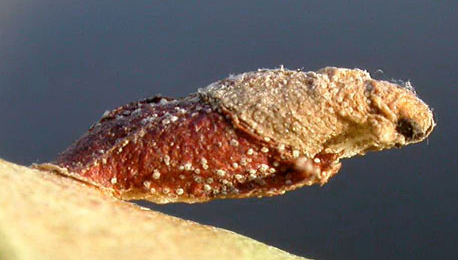 Case of Coleophora orbitella on Betula pendula Image: © Willem Ellis (Bladmineerders van Europa) |
|
Coleophora orbitella Zeller, 1849 [Lepidoptera: Coleophoridae]. |
2g > Leaf-miner and case-bearer: The larva feeds by inserting its head into small mines it creates on the leaves of birch, elm, alder, or hazel. Occasionally it is found feeding on other trees, or on herbaceous plants onto which it has accidentally Fallén. It forms two cases during its larval life. The first case is initially curved, smooth, laterally compressed with a bivalved anal opening, and about 2 mm long in September. During October it feeds, and adds a few rough collars of larval material around the oral opening. After hibernation, it feeds again in April and early May, adding more protruding collars until they equal or exceed the original smooth part of the case. At the same time, it expands the case girth by the creation of a silk gusset ventrally. The second case, 6 or 7 mm long, is formed in May, leaving the vacated first case attached to its last feeding mine. The new case is tubular with a trivalved crimp at the anal opening. The dorsum is formed from the edge of the leaf from which the case was cut. This results in a more or less serrated dorsal keel, depending on the plant species and the individual piece of leaf used. Considerable variation in the degree of serration can be found, even among specimens off the same tree. The case colour varies with food plant, from yellowish brown on birch, darkening through elm and hazel to dark brown on alder. The strongly curved young case is is a composite leaf case, the adult case is a tubular leaf case. The adult case is bivalved, about 7 mm in length; the mouth angle is around 30°. The case is straw coloured and almost always has a toothed dorsal keel (remnant of the margin of the leaf from which the case was cut). Neither larvae or cases of C. coracipennella, prunifoliae, serratella and spinella can be separated; from serratella. |
|
Coleophora serratella (Linnaeus, 1761) [Lepidoptera: Coleophoridae]. |
2h > Leaf-miner and case-bearer: Tubular leaf case. The case is almost barrel-shaped, with a large leaf fragment that, while withering, folds itself untidily arround the tube. A biennial life cycle in the UK (may be annual in continental Europe). The second and third cases are formed by cutting out a large leaf portion and then wrapping it around - leaving an edge protruding, which then withers. |
|
Coleophora siccifolia Stainton, 1856 [Lepidoptera: Coleophoridae]. |
2i > Leaf-miner and case-bearer: The larva feeds on a wide range of trees, shrubs and herbs, favouring Rosaceae, but not exclusively. The fully developed cased larva may be found active in October and again, after winter diapause, in April. Cases, about 6 mm, of diapausing larvae may be found through winter, fixed to a tree or fence post. The dorsal surface of the case is usually covered in leaf fragments, but they can sometimes be worn off almost smooth. The ventral surface is swollen at the middle and has a keel, which usually bends upwards at the posterior. The cases of C. ahenella (on Rhamnus, Frangula, Viburnum and Cornus) and C. potentillae (case less swollen, keel not bent up, resting position less prone) are very similar. Brownish lobe case that lies almost flat on the leaf, either on the upper or on the lower side. Case widest about the middle. Ventrally there is a distinct keel. Mouth angle 0°. Full depth mines rather large. The flaps of cuticular tissue that serve to enlarge the case are cut out of the upper epidermis. (contrary to C. ahenella and C. potentillae, that use tissue from the lower epidermis). The removal of these tissue flaps creates holes that are much larger than those that serve as the entrance to the mine. |
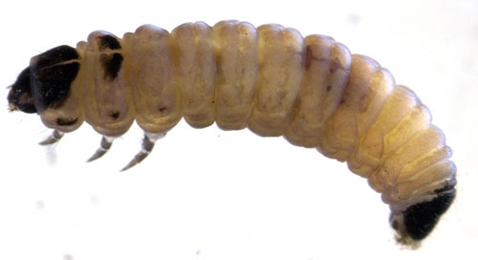 Coleophora violacea larva, lateral Image: © Willem Ellis (Bladmineerders van Europa) |
|
Coleophora violacea (Ström, 1783) [Lepidoptera: Coleophoridae]. |
3a > Leaf-miner: The larvae mine the leaves at first, then create small feeding windows. Small, full depth, hook-like corridor, usually in a vein axil, with a proportionally large larval chamber. The remainder of the mine almost entirely stuffed with frass. At the start if the mine an iridescent egg shell. The larvae soon leave their mine and start living free on the leaf. The pupa and white ribbed cocoon are illustrated in British leafminers. |
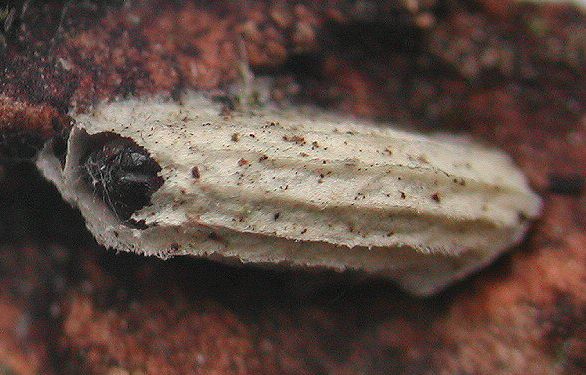 Bucculatrix thoracella cocoon Image: Rob Edmunds (British leafminers) |
|
Bucculatrix thoracella (Thunberg, 1794) [Lepidoptera: Bucculatricidae]. |
3b > Leaf-miner: The larvae mine leaves at first, forming a blotch mine, later descending to the ground in a portable case and feeding on dead leaves. Oviposition is by way of an ovipositor, therefore no egg shell visible. The larva makes a small, roundish, blotch; often several in a leaf. Already after its first moult it makes an excision out of the mine, in size almost equal to the blotch (3-4 mm). Thus sandwiched it drops to the ground and continues feeding on dead leaf material. |
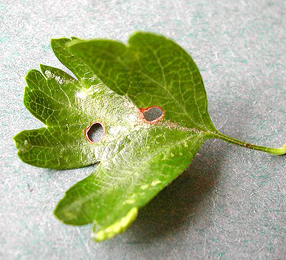 Mines of Incurvaria masculella Image: © Rob Edmunds (British leafminers) |
|
Incurvaria masculella (Denis & Schiffermüller, 1775) [Lepidoptera: Incurvariidae]. |
3c > Leaf-miner: Oviposition by way of an ovipositor, no egg visible therefore. The larva makes an irregular blotch. The part of the mine nearest to the oviposition site is more thranslucent than the later, in transparancy more greenish, part of the mine. The mine usually lies close to the leaf tip, often several together. After its first moult the larva makes a roundish excision, 3-4 mm in diameter. Incurvaria larvae, while resting, take a horse-shoe like posture, unlike the larvae of Antispila species. Sandwiched herein it drops to the ground and continues feeding of dead leaves. The excision occupies about half of the surface of the blotch. The mine is also described in. |
|
Incurvaria oehlmanniella (Hübner, 1796) [Lepidoptera: Incurvariidae]. |
3d > Leaf-miner: The larva starts making a corridor of a few mm, followed, and mostly overrun, by a circular blotch of 4-5 mm diameter. Generally several larvae feed in a single leaf, creating a distinctive pattern of feeding windows. The larvae then cut out circular cases and drop to the leaf-litter to continue feeding, leaving behind a leaf containing many circular or oval cut-outs. |
|
Incurvaria pectinea Haworth 1828 [Lepidoptera: Incurvariidae]. |
3e > Leaf-miner: The larva feeds on hazel or hornbeam, creating blotches with intertwining threads of frass, typical of the genus. Large white blotch, starting at the leaf margin. Frass in long threads. Often several larvae in a mine. Pupation outside the mine. |
|
Eriocrania chrysolepidella (Zeller, 1851) [Lepidoptera: Eriocraniidae]. |
3f > Leaf-miner: The initial mine expands to form a full depth blotch. It resembles Phyllonorycter tenerella, but has a mottled lower surface. It then forms two folds. Small, angular, full depth blotch, often in a vein axil. Lower, in the end also upper, epidermis brown. The larva deposits some silk in the mine, but the quantity is so low that the mine remains practicaly flat. Later the larva leaves the mine and continues feeding within a downfolded leaf margin or leaf tip. |
|
Parornix carpinella (Frey, 1863) [Lepidoptera: Gracillariidae]. |
3g > Leaf-miner: The mine is upper side, over veins. Silvery, with brown speckling, later contracting to cause leaf to fold upwards. Upper-surface tentiform mine. The early mine is roundish, silvery, flat, and lies centered over a side vein. The older mine strongly contracts and sometimes almost doubles the leaf. |
|
Phyllonorycter esperella (Goeze, 1783) [Lepidoptera: Gracillariidae]. |
3h > Leaf-miner: The mine is oval on Q. ilex (note - there may be several mines in the leaf), and similar to P. quercifoliella on deciduous oaks. It is between adjacent veins on beech and hornbeam. Small, oval, lower-surface tentiform mine, 9-14 mm long, mostly between two lateral veins. The lower epidermis with a single sharp fold (sometimes forked near its end). Pupa in very flimsy cocoon, that contains a bit of frass laterally and at the rear end. |
|
Phyllonorycter messaniella (Zeller, 1846) [Lepidoptera: Gracillariidae]. |
3i > Leaf-miner: The mine is oval, sometimes crossing veins. The lower epidermis with several strong creases. Along with P. tristrigella, this species feeds on elm, although not usually on wych elm like that species. However the two mines are quite different - schreberella forming a rounded mine and tristrigella a longer, narrower tube-like mine. Short, roundish to oval, somewhat inflated, lower surface tentiform mine, often crossing a lateral vein. Epidermis with several length folds. Dark brown pupa in a tough, greenish cocoon; the cocoon lies free in the mine, and its wall is not encrusted with frass. |
|
? Phyllonorycter schreberella (Fabricius, 1781) [Lepidoptera: Gracillariidae]. |
2j > Leaf-miner: A mine between veins from midrib to leaf-edge, narrow, tubular, with one crease in lower epidermis. Narrow, finally tubular lower-surface mine between two side veins. The lower epidermis with one strong fold. Pupa in a flimsy cocoon in a corner of the mine, usually in the axil of midrib and side vein. Frass loosely heaped in the opposite corner. |
|
Phyllonorycter tenerella (Joannis, 1915) [Lepidoptera: Gracillariidae]. |
3k > Leaf-miner: Oviposition at the underside of the leaf, in the axil of a vein. The mine is a not very slender corridor. The first part is almost filled with frass; in the later part the frass lies in thick lumps. The trajectory of the mine is not angular, neither is it determined by the leaf venation. The discrimination between this mine and the one of Stigmella floslactella is difficult. |
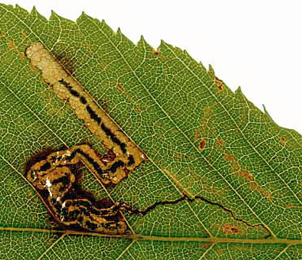 Mine of Stigmella carpinella on Carpinus betulus Image: © Willem Ellis (Bladmineerders van Europa) |
|
Stigmella carpinella (Heinemann, 1862) [Lepidoptera: Nepticulidae]. |
3l > Leaf-miner: The early gallery is filled with frass, later leaving clear margins. Like Stigmella microtheriella the larva feeds on hazel or hornbeam, and its mines are often found alongside that species in the same leaf. However the mines of S. floslactella are generally wider, less angular and contain more scattered frass than those of S. microtheriella. Oviposition at the underside of the leaf, in a vein axil. Mine a slender, gradually widening corridor; the last section is clearly wider than the larva. In the first section the vaguely delimited frass line almost fills the corridor. Later the frass lies in irregular arcs and clouds, filling about one third of the width of the corridor. The trajectory of the mine is not angular, independent of the leaf venation. Pupation external, exit slit in the upper epidermis. |
|
Stigmella floslactella (Haworth, 1828) [Lepidoptera: Nepticulidae]. |
3m > Leaf-miner: A narrow gallery, tending to follow veins of leaf. The early part with linear frass. Oviposition at the underside of the leaf, mostly close to a vein. The mine is a long, very slender corridor; even towards the end hardly wider than necessary to accomodate the growing larva. Frass in a narrow central line. The shape of the mine differs somewhat between the hostplants. In Carpinus the mine closely follows a heavy vein over a long distance; also the mine tends to be somewhat shorter and broader, and the frass often lies in a more diffuse line. The mines in Corylus are not so strictly defined by the venation and the frass line is narrower (Emmet, 1983a; Johansson ao, 1990a). Sometimes it is difficult to separate the mines from those of S. floslactella; an additional difference then is that even in the very first part of the corridor the frass of microtheriella lies in a narrow line, while the frass of floslactella seems to fill the entire corridor there. The pale golden larva lies venter-upwards in the mine. Sometimes there can be several larvae mining the same leaf. |
|
Stigmella microtheriella (Stainton, 1854) [Lepidoptera: Nepticulidae]. |
3n > Leaf-miner: Full depth blotch, invariably beginning at the leaf tip or the tip of a leaf lobe or tooth. Oviposition site covered by a black, shining drop of hardened secretion. Frass generally in long threads, but sometimes in elongated granules. Pupation in the mine, not in a cocoon. |
|
Trachys minutus (Linnaeus, 1758) [Coleoptera: Buprestidae]. |
| Last updated 01-Jul-2019 Brian Pitkin | ||
